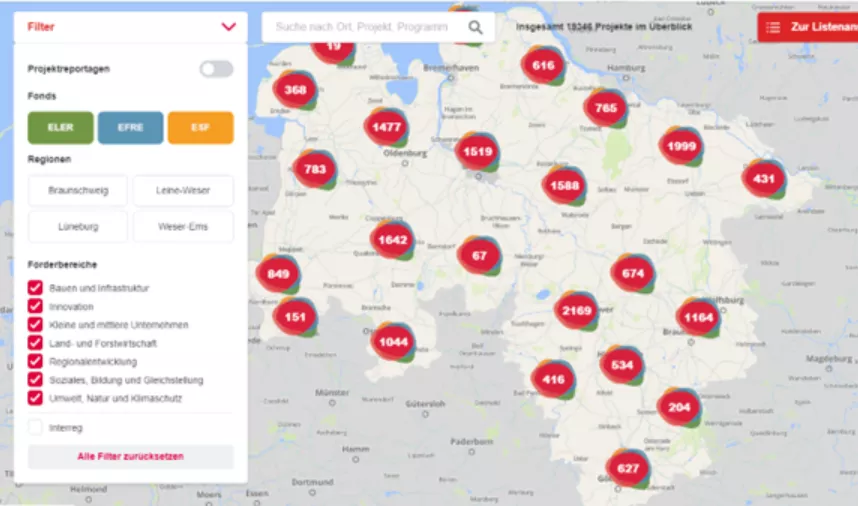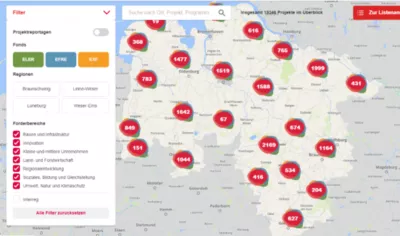Summary
Lower Saxony created in 2017 the Ministry for Federal and European Affairs and Regional Development to set up a coordinated governance system, improving cross-funding coordination and promoting territorial approaches. The new structure facilitates strategic planning, knowledge consolidation, and harmonised regulations.
For the 2021-2027 funding period, Lower Saxony devised a cross-fund strategic framework centred on three key objectives – innovation, climate protection, and biodiversity – to ensure the future resilience of all rural regions. The strategy emphasises place-based approaches, tailored funding instruments addressing local needs, and synergies between European funds for improved efficiency.
Results
The new governance structure and strategy delivered concrete results:
- establishment of a modular system of territorial instruments at different scales, including urban and rural areas. This covers the ERDF instruments ‘resilient city centres’ and the ‘future regions’, combining ERDF and ESF+ funding and the EARDF LEADER regions.
- a complementary ‘division of labour’ for certain fields of action, such as rewetting of peatlands. While the EAFRD promotes the raising of ground water levels and peatland-friendly farming practices, the ERDF promotes innovation and research into new practices and marketable products.
Several mechanisms have been set up to improve implementation coordination:
- regular meetings of ERDF/ESF+ MA,EAFRD coordination unit and EAFRD MA;
- reciprocal membership in the Monitoring Committees;
- common reporting of EAFRD, ERDF, ESF+ approval and disbursement data;
- joint public relation work: Europe for Lower Saxony (homepage, interactive project atlas etc.) and joint activities, such as regional dialogues for simplification and reduction of administrative burden.
Resources
Documents
Context
The European Regional Development Fund (ERDF), European Social Fund (ESF) and European Agricultural Fund for Rural Development (EAFRD) in Lower Saxony were programmed, implemented and monitored separately and largely without effective coordination. Synergies among the funds, including those for strengthening rural regions, could not be leveraged due to a lack of an overarching strategy at both national and regional levels.
The Ministry for Federal and European Affairs and Regional Development was founded in 2017 to tackle this problem. The ERDF/ESF Managing Authority (MA) was transferred to this new Ministry and a new EAFRD coordination was set up in the same unit. The EAFRD MA remained in the Ministry of Agriculture due to its close connection to the European Agricultural Guarantee Fund (EAGF). At regional level, four offices for regional development are responsible for cross-fund coordination.
Objectives
-
Set up a coordinated governance system for the EAFRD, ERDF and ESF+ programmes;
-
Improve cross-funding coordination for a more efficient use of resources;
-
Ensure a strategic approach: coordinating priorities and aligning EU programmes;
-
Consolidate knowledge and expertise;
-
Harmonise rules and regulations where possible;
-
Implement a common reporting system to monitor the regional uptake of ERDF/ESF and EAFRD;
-
Promote territorial approaches and tailored solutions for the different regions of Lower Saxony across all funds.
Activities, key actors, and timeline
In 2017, the new Lower Saxon Ministry for Federal and European Affairs and Regional Development was created after a two-stage re-organisation process through which the ERDF and ESF MAs merged. A strategic coordination plan was also set up with the EAFRD MA in the State Office, alongside the establishment of four regional development offices. The establishment of the new Ministry marked a significant turning point, fostering enhanced strategic approaches, shared objectives, consolidated knowledge, and harmonised regulations.
In 2018, the European Ministry was commissioned by the federal state to develop a comprehensive funding landscape in order to coordinate funds efficiently and streamline procedures. This was achieved thanks to a comprehensive EU funding strategy developed on the basis of extensive bottom-up consultations engaging over 500 of civil society and academia representatives, and economic actors.
As a result, three objectives served as strategic safeguard for the subsequent programming of the support interventions:
-
innovative and intelligent economic change based on sustainable education and research;
-
environment and climate protection;
-
strong and sustainable (future-oriented) rural areas.
The strategy responds to a high demand for place-based approaches to adapt funding instruments to regional needs.
Success factors/lessons learnt
-
A clear political mandate for cross-fund strategy was key for the new governance structure;
-
Integration of EAFRD into the Common Provisions Regulation and recognition of EAFRD as a structural fund drove impetus for change;
-
Transfer of the ESF+/ERDF MA to a ministry responsible for regional development facilitated territorial approaches in EU funding;
-
The long-term success depends on the future design of EU funding framework post 2027;
Obstacles to deeper coordination arise due to new arrangements within the Common Agricultural Policy (CAP):
-
EAFRD no longer being part of the Structural Funds family gradually weakens bonds;
-
Integration of EAFRD in single national CAP strategic plans, including EAFRD and EAGF, poses a main challenge for effective cross-fund coordination;
-
The programming and implementation of German CAP strategic plans require exhaustive coordination between federal states and national level, EAFRD and EAGF units, and among all German federal states to harmonise interventions;
-
Limited resources available for non-mandatory activities, such as coordination between EAFRD and other funds, are expected to focus on agriculture-related matters within the CAP strategic plans, overshadowing rural development.
Contacts
Barbara Fährmann, Head of Unit, EAFRD-coordination, rural regions: Barbara.Faehrmann@mb.niedersachsen.de

